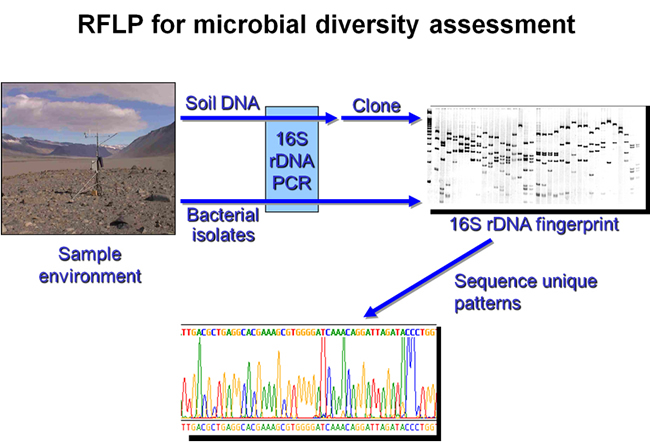Microbail diversity of soils of the Ross Sea Region, Antarctica
Soils of the Ross Sea Region of Antarctica are unique. In this environment the existence of life is significantly constrained by the availability of liquid water and organic carbon. As a consequence, these environments are largely the domain of microorganisms, notably bacteria, archaea, fungi, microalgae and limited species of protozoa, rotifers, tardigrades, nematodes, mites and springtails.
We and others have examined the bacterial and archaeal diversity of RSR soils using DNA-based culture-independent methods that rely on the direct amplification of ribosomal RNA genes from the soils (Figure 1). In addition, culture-based studies, where we grow the bacteria, have provided organisms for investigations of their carbon metabolism and mechanisms for survival in the Antarctic environment.
 |
| Figure 1. Schematic showing the approach we have taken to analyse Antarctic soils. |
Bacterial diversity
The application of DNA-based culture-independent methods to the analysis of Antarctic mineral soils has revealed the prevalence of bacteria belonging to the Phyla Actinobacteria, Proteobacteria, Deinococcus–Thermus, Acidobacteria, Gemmatimonadetes, BacteroIdetes and Cyanobacteria, although their prevalence may vary from site to site (Figure 2). Except for Deinococcus–Thermus and Cyanobacteria, they are among the phyla commonly reported in soil clone libraries. In ornithogenic soils occupied by penguins we have found a prevalence of bacteria belonging to Firmicutes.
Cyanobacteria and algae are the primary producers in soils of the Ross Sea Region, whereas members of the other bacterial phyla present are typically heterotrophs. In soil, Actinobacteria, for example, are common soil saprophytes recognised for their ability to metabolise a wide range of substrates including sugars and amino acids. In contrast, relatives of the Bacteroidetes aerobically degrade polymers such as starch, gelatin, casein, xylan, and Tween 80. Firmicutes include heterotrophic bacteria that produce endospores, which allow the bacterium to survive inhospitable conditions.
Many of the clones that have been obtained from soils of the Ross Sea Region were most similar to isolates or clones reported previously from Antarctic terrestrial sources including soil, cryptoendoliths, and lakes. The closest cultured relatives of the clones include members of the genera Arthrobacter, Nocardioides, Hymenobacter, Brevundimonas, Sphingomonas, Sporosarcina and Leptolyngbya, all of which have been isolated from Antarctic soil. These bacteria are cold tolerant and often form pigmented colonies on agar plates (Figure 3). Pigment production in heterotrophic bacteria has been implicated in tolerance to ultraviolet. Some clones have no close known relatives, indicating that soils of the Ross Sea Region may be a natural resource of novel, cold-adapted bacteria.
Antarctic soil bacterial communities exhibit spatial patterns, with the most diverse and abundant communities occurring on the coast but declining away from the coast and with altitude. Numbers of bacteria appear to decline with soil depth, although there are reports of higher numbers at the interface of the soil and ice-cemented permafrost. Microbes are more abundant in ornithogenic soil than mineral soils. Investigations of the microbial ecology of Dry Valley soils, using culturing-dependent methods, indicate that bacterial abundance and diversity can vary with soil factors such as pH, moisture, available nutrients, salinity, slope, drainage, and solar radiation.
 |
 |
 |
| Br 8 | Br 12 | Br 18 |
 |
 |
 |
| H11 | H29 | H33 |
Figure 3. Pigmented colonies on agar plates (click to enlarge).
Archaeal diversity
Our investigations of Archaea indicate they are not abundant in soils of the Ross Sea Region. Using molecular tools we detected Archaea in coastal soils from Scott Base, Marble Point, Granite Harbour and Minna Bluff. We also detected them in Dry Valley soils from Victoria Valley but not in Wright Valley. No Archaea were detected in ornithogenic soils. Most of the clones (>99%) we retrieved from the soils belonged to Crenarchaeota group 1.1b. In temperate soils it has been suggested that Crenarchaeota belonging to group 1.1b are nitrifiers. That is, they are chemoautotrophs and obtain their energy from oxidation of ammonia to drive fixation of carbon dioxide. Metagenomic studies have revealed that members of Crenarchaeota group 1.1b contain and express genes encoding the ammonia monoxygenase enzyme complex, the first enzyme in the pathway for nitrification.
Impact of environmental conditions on microbial abundance and diversity
Antarctic soil microbial communities exhibit spatial patterns, with the most diverse and abundant communities occurring on the coast but declining away from the coast and with altitude. Numbers of bacteria appear to decline with soil depth, although there are reports of higher numbers at the interface of the soil and ice-cemented permafrost. Microbes are more abundant in ornithogenic soil than mineral soils. Investigations of the microbial ecology of Dry Valley soils, using culturing-dependent methods, indicate that bacterial abundance and diversity can vary with soil factors such as pH, moisture, available nutrients, salinity, slope, drainage, and solar radiation.
